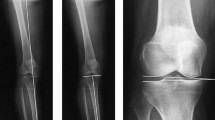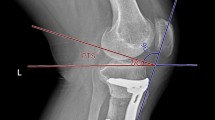Abstract
Purpose
The purpose of the present study was to compare the change in tibial posterior slope angle (PSA) between patients treated via computer-assisted and conventional closed-wedge high tibial osteotomy (CWHTO). It was hypothesized that a decrease in the PSA would be less in the computer-assisted group than in the conventional group.
Methods
Data on a total of 75 computer-assisted CWHTOs (60 patients) and 75 conventional CWHTOs (49 patients) were retrospectively compared using matched pair analysis. The pre- and postoperative mechanical axis (MA) and the PSA were radiographically evaluated. The parallel angle was defined as the angle between the joint line and the osteotomy surface. The data were compared between the two groups.
Results
The postoperative radiographic MA averaged 1.3° ± 2.6° valgus in the computer-assisted group and 0.3° ± 3.1° varus in the conventional group. The change in PSA averaged −0.8° ± 0.9° in the computer-assisted group and −4.0° ± 2.2° in the conventional group. The parallel angle averaged 0.2° ± 3.0° in the computer-assisted group and 6.2° ± 5.3° in the conventional group.
Conclusion
Computer-assisted CWHTO using four guide pins could avoid inadvertent change in the PSA. The navigation can be used in anticipation of decreasing the risk of change in the PSA in CWHTO, especially in patients whose preoperative PSA is small. The special attention should be paid to locate the hinge axis acutely and to make the parallel proximal and distal osteotomy surfaces during CWHTO.
Level of evidence
III.



Similar content being viewed by others
References
Agneskirchner JD, Hurschler C, Stukenborg-Colsman C, Imhoff AB, Lobenhoffer P (2004) Effect of high tibial flexion osteotomy on cartilage pressure and joint kinematics: a biomechanical study in human cadaveric knees. Winner of the AGA-DonJoy Award 2004. Arch Orthop Trauma Surg 124:575–584
Asada S, Akagi M, Mori S, Matsushita T, Hashimoto K, Hamanishi C (2012) Increase in posterior tibial slope would result in correction loss in frontal plane after medial open-wedge high tibial osteotomy. Knee Surg Sports Traumatol Arthrosc 20:571–578
Bae DK, Mun MS, Kwon OS (1997) A newly designed miniplate staple for high tibial osteotomy. Bull Hosp Jt Dis 56:167–170
Bae DK, Song SJ, Yoon KH (2009) Closed-wedge high tibial osteotomy using computer-assisted surgery compared to the conventional technique. J Bone Joint Surg Br 91:1164–1171
Blackman AJ, Krych AJ, Engasser WM, Levy BA, Stuart MJ (2015) Does proximal tibial osteotomy with a novel osteotomy system obtain coronal plane correction without affecting tibial slope and patellar height? Knee Surg Sports Traumatol Arthrosc 23:3487–3493
Brandon ML, Haynes PT, Bonamo JR, Flynn MI, Barrett GR, Sherman MF (2006) The association between posterior-inferior tibial slope and anterior cruciate ligament insufficiency. Arthroscopy 22:894–899
Brouwer RW, Bierma-Zeinstra SM, van Koeveringe AJ, Verhaar JA (2005) Patellar height and the inclination of the tibial plateau after high tibial osteotomy. The open versus the closed-wedge technique. J Bone Joint Surg Br 87:1227–1232
Chan YH (2003) Biostatistics 104: correlational analysis. Singap Med J 44:614–619
Coventry MB, Ilstrup DM, Wallrichs SL (1993) Proximal tibial osteotomy. A critical long-term study of eighty-seven cases. J Bone Joint Surg Am 75:196–201
Dubrana F, Lecerf G, Nguyen-Khanh JP, Menard R, Ardouin L, Gibon Y, Pidhorz L, Falaise V, Coipeau P, Burdin P, Rouvillain JL, Navarre T, Garron E, Daoud W, Louboutin H, Moineau G, Wessely L, Stindel E, Debarge R, Lustig S, Lavoie F, Neyret P (2008) Tibial valgus osteotomy. Rev Chir Orthop Reparatrice Appar Mot 94:S2–S21
Ducat A, Sariali E, Lebel B, Mertl P, Hernigou P, Flecher X, Zayni R, Bonnin M, Jalil R, Amzallag J, Rosset P, Servien E, Gaudot F, Judet T, Catonne Y (2012) Posterior tibial slope changes after opening- and closing-wedge high tibial osteotomy: a comparative prospective multicenter study. Orthop Traumatol Surg Res 98:68–74
El-Azab H, Glabgly P, Paul J, Imhoff AB, Hinterwimmer S (2010) Patellar height and posterior tibial slope after open- and closed-wedge high tibial osteotomy: a radiological study on 100 patients. Am J Sports Med 38:323–329
El-Azab H, Halawa A, Anetzberger H, Imhoff AB, Hinterwimmer S (2008) The effect of closed- and open-wedge high tibial osteotomy on tibial slope: a retrospective radiological review of 120 cases. J Bone Joint Surg Br 90:1193–1197
Fowler JR, Ilyas AM (2011) The accuracy of digital radiography in orthopaedic applications. Clin Orthop Relat Res 469:1781–1784
Goleski P, Warkentine B, Lo D, Gyuricza C, Kendoff D, Pearle AD (2008) Reliability of navigated lower limb alignment in high tibial osteotomies. Am J Sports Med 36:2179–2186
Hauschild O, Konstantinidis L, Strohm PC, Niemeyer P, Suedkamp NP, Helwig P (2009) Reliability of leg alignment using the OrthoPilot system depends on knee position: a cadaveric study. Knee Surg Sports Traumatol Arthrosc 17:1143–1151
Hernigou P, Medevielle D, Debeyre J, Goutallier D (1987) Proximal tibial osteotomy for osteoarthritis with varus deformity. A ten to thirteen-year follow-up study. J Bone Joint Surg Am 69:332–354
Hoell S, Suttmoeller J, Stoll V, Fuchs S, Gosheger G (2005) The high tibial osteotomy, open versus closed wedge, a comparison of methods in 108 patients. Arch Orthop Trauma Surg 125:638–643
Hohmann E, Bryant A, Imhoff AB (2006) The effect of closed wedge high tibial osteotomy on tibial slope: a radiographic study. Knee Surg Sports Traumatol Arthrosc 14:454–459
Jacobi M, Villa V, Reischl N, Demey G, Goy D, Neyret P, Gautier E, Magnussen RA (2015) Factors influencing posterior tibial slope and tibial rotation in opening wedge high tibial osteotomy. Knee Surg Sports Traumatol Arthrosc 23:2762–2768
Kaper BP, Bourne RB, Rorabeck CH, Macdonald SJ (2001) Patellar infera after high tibial osteotomy. J Arthr 16:168–173
Kendoff D, Board TN, Citak M, Gardner MJ, Hankemeier S, Ostermeier S, Krettek C, Hufner T (2008) Navigated lower limb axis measurements: influence of mechanical weight-bearing simulation. J Orthop Res 26:553–561
Kendoff D, Citak M, Pearle A, Gardner MJ, Hankemeier S, Krettek C, Hufner T (2007) Influence of lower limb rotation in navigated alignment analysis: implications for high tibial osteotomies. Knee Surg Sports Traumatol Arthrosc 15:1003–1008
Kendoff D, Lo D, Goleski P, Warkentine B, O’Loughlin PF, Pearle AD (2008) Open wedge tibial osteotomies influence on axial rotation and tibial slope. Knee Surg Sports Traumatol Arthrosc 16:904–910
Keppler P, Gebhard F, Grutzner PA, Wang G, Zheng G, Hufner T, Hankemeier S, Nolte LP (2004) Computer aided high tibial open wedge osteotomy. Injury 35(Suppl 1):S-A68–S-A78
Krettek C, Miclau T, Grun O, Schandelmaier P, Tscherne H (1998) Intraoperative control of axes, rotation and length in femoral and tibial fractures. Technical note. Injury 29(Suppl 3):C29–C39
Lachin JM (2004) The role of measurement reliability in clinical trials. Clin Trials 1:553–566
LaPrade RF, Oro FB, Ziegler CG, Wijdicks CA, Walsh MP (2010) Patellar height and tibial slope after opening-wedge proximal tibial osteotomy: a prospective study. Am J Sports Med 38:160–170
Lee YS, Kim MG, Byun HW, Kim SB, Kim JG (2015) Reliability of the imaging software in the preoperative planning of the open-wedge high tibial osteotomy. Knee Surg Sports Traumatol Arthrosc 23:846–851
Lustig S, Scholes CJ, Costa AJ, Coolican MJ, Parker DA (2013) Different changes in slope between the medial and lateral tibial plateau after open-wedge high tibial osteotomy. Knee Surg Sports Traumatol Arthrosc 21:32–38
Noyes FR, Goebel SX, West J (2005) Opening wedge tibial osteotomy: the 3-triangle method to correct axial alignment and tibial slope. Am J Sports Med 33:378–387
Okal F, Hart R, Komzak M, Safi A (2013) Computer-assisted kinematic 2D and 3D navigation in medial opening-wedge high-tibial valgus osteotomy. Acta Chir Orthop Traumatol Cech 80:159–164
Ozalay M, Ozkoc G, Circi E, Akpinar S, Hersekli MA, Uysal M, Cesur N (2008) The correlation of correction magnitude and tibial slope changes following open wedge high tibial osteotomy. Knee Surg Sports Traumatol Arthrosc 16:948–951
Ozel O, Yucel B, Mutlu S, Orman O, Mutlu H (2015) Changes in posterior tibial slope angle in patients undergoing open-wedge high tibial osteotomy for varus gonarthrosis. Knee Surg Sports Traumatol Arthrosc 2015 Mar 13 [Epub ahead of print]
Petrigliano FA, Suero EM, Voos JE, Pearle AD, Allen AA (2012) The effect of proximal tibial slope on dynamic stability testing of the posterior cruciate ligament- and posterolateral corner-deficient knee. Am J Sports Med 40:1322–1328
Reising K, Strohm PC, Hauschild O, Schmal H, Khattab M, Sudkamp NP, Niemeyer P (2013) Computer-assisted navigation for the intraoperative assessment of lower limb alignment in high tibial osteotomy can avoid outliers compared with the conventional technique. Knee Surg Sports Traumatol Arthrosc 21:181–188
Saragaglia D, Chedal-Bornu B (2014) Computer-assisted osteotomy for valgus knees: medium-term results of 29 cases. Orthop Traumatol Surg Res 100:527–530
Author information
Authors and Affiliations
Corresponding author
Rights and permissions
About this article
Cite this article
Bae, D.K., Ko, Y.W., Kim, S.J. et al. Computer-assisted navigation decreases the change in the tibial posterior slope angle after closed-wedge high tibial osteotomy. Knee Surg Sports Traumatol Arthrosc 24, 3433–3440 (2016). https://doi.org/10.1007/s00167-016-4032-2
Received:
Accepted:
Published:
Issue Date:
DOI: https://doi.org/10.1007/s00167-016-4032-2




